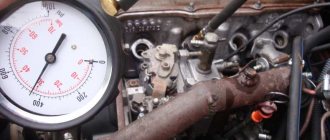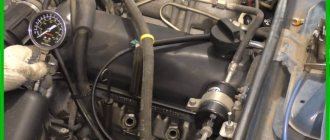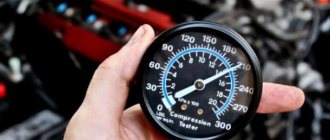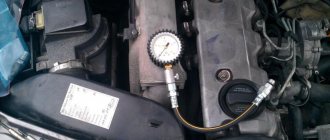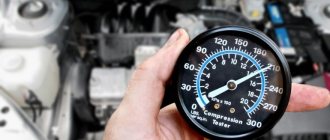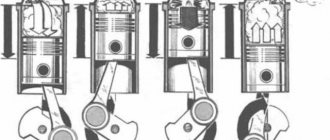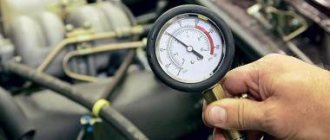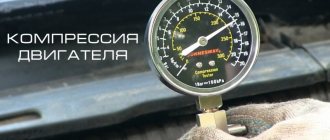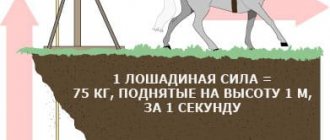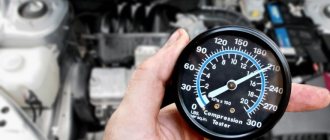The first signs of engine wear are difficult cold starting and increased oil consumption (over 150 ml per 1 thousand kilometers). When such symptoms appear, a compression test is performed in the engine cylinders, which helps to more accurately determine the technical condition of the cylinder-piston and valve group. To carry out such diagnostics, it is not necessary to go to a car service: it is enough to get a special pressure gauge and understand what the compression should be in a working power unit.
Compression End Pressure
Compression is a popular expression, the correct term is “compression end pressure.”
It is created in the cylinder by the movement of the piston when the ignition is turned off and without fuel supply. To measure the pressure in the cylinders, technicians in technical services usually use a special device - a compression meter, which is screwed in instead of a spark plug. The measuring element is inside the cylinder. Next, the crankshaft is spun by the starter, and the arrow shows a certain value on the scale.
The higher the compression, the more power the power unit can develop. It depends on the condition of the piston rings and their degree of wear. The valve plates gradually burn out, do not fit tightly into the seat and allow gases to pass through. A “stuck” valve or a burnt-out piston does not allow the required pressure to be created in the cylinder.
If they are damaged, gases penetrate into the crankcase, the engine cannot develop its designed power, and its characteristics are distorted. If in one cylinder the compression is 25% lower than in the others, then engine repair with complete disassembly is necessary.
Normal compression values for common 1.6-liter naturally aspirated engines are considered to be 11-12 bar. In old VAZ carburetor engines, the minimum threshold is 10 bar. A new unit in excellent condition should show 13 bar just off the assembly line.
It is impossible to increase compression indefinitely due to the risk of detonation. The air-fuel mixture heats up during compression and can ignite randomly even before the compression cycle is completed. That is, the mixture will explode ahead of time, causing damage to engine parts.
What is it and what malfunctions can cause it to fall
In fact, there is a misconception that the higher the engine compression, the higher its efficiency (efficiency), power and lower fuel consumption. Actually this is not true. On the contrary, if at an abnormally high level of compression you measure the fuel consumption, say, on a domestic-made engine installed on a VAZ 2109, then depending on the operating mode, the fuel consumption will be either really less (at low speeds) or even more (at intensive “ promotion”, acceleration of speed above 1000 rpm). The same goes for power. If you check it on a bench, then with high compression the engine becomes more “torque” at low speeds, and the difference is not felt at all at high speeds.
This is where normal and high engine compression really helps a lot - cold starts. Moreover, this issue is relevant, first of all, specifically for diesel engines. Which, firstly, due to the characteristics of the fuel used, require a compression level twice (minimum) higher than on engines of the same domestic VAZ 2109. And secondly, ignition of diesel fuel during a cold start is significantly difficult... but, about everything in order.
What factors influence compression?
The fuel cylinder is a working chamber of volumetric displacement. It is a closed-type system consisting of a large number of parts:
- valves;
- cylinder head;
- piston and rings;
- cylinder walls.
Each element affects the performance of the system. If one of them is damaged or severely worn, the pressure decreases. A cracked piston will lead to exhaust gas leakage. This will have a bad effect on power characteristics.
The pressure level often decreases due to damaged or dirty rings. Incorrectly set valve timing, low-quality composition of the working mixture, and an incorrect injection timing angle also cause the formation of carbon deposits in the valves. This ultimately leads to loss of pressure and further problems.
Standards and norms
There is an opinion among owners of modern cars that the compression of a hot engine can be from 8 to 10 atm.
The compression rate in the cylinders of any engine is from 12 atm, with rare exceptions.
Cars use engines of various configurations, determined by the number of valves and camshafts, the geometry of the intake manifold, and the installed connecting rod and piston group. In accordance with this, its specific compression ratio is calculated - this is the ratio of the total volume of the cylinder to the volume of the combustion chamber.
The higher the compression ratio, the higher the compression value. For gasoline engines, the compression ratio is in the range of 8 - 12 units, which is indicated in the technical documentation of a particular car. Theoretically, it is not difficult to determine what the compression in the cylinders should be for a particular engine. It is enough to multiply the compression ratio by a factor of 1.3.
For example, the compression ratio in the car’s characteristics is indicated as 9.5 units, multiplying 9.5 by a factor of 1.3 to obtain a calculated value of 12.35 atm.
Compression and compression ratio
Normal engine compression depends on the compression ratio. It is determined by the formula - compression ratio multiplied by 1.3. That is, for engines with a compression ratio of 8–9, the compression should be at least 11 atmospheres (from 10.4 to 11.7). For engines with a compression ratio of 10 and higher, normal compression should be at least 13 atmospheres. The normal compression of a diesel engine should be at least 26, which corresponds to a compression ratio of 20. If the compression on a cold engine is lower by more than 1 atmosphere, it is necessary to determine what malfunction led to this and eliminate it. Otherwise, the life of the motor will begin to decline and soon more complex and expensive repairs will be required.
The first signs of engine wear are difficult cold starting and increased oil consumption (over 150 ml per 1 thousand kilometers). When such symptoms appear, a compression test is performed in the engine cylinders, which helps to more accurately determine the technical condition of the cylinder-piston and valve group. To carry out such diagnostics, it is not necessary to go to a car service: it is enough to get a special pressure gauge and understand what the compression should be in a working power unit.
Compression testers
A compression gauge is a device consisting of a pressure gauge with a scale, a pressure relief valve and tips. The most convenient is a flexible hose with a threaded end, in which a nipple is installed to prevent air from escaping back out of the device. Checking compression in engine cylinders that include spark plug wells in their design is carried out by screwing a flexible hose into the threaded hole of the spark plug, which eliminates the loss of compressed air from loose fitting of rigid tips without threads.
How to measure compression
To assess the technical condition of the cylinders and piston group elements, a special device is used - a compression meter.
It includes the following elements:
- Pointer pressure gauge with scale graduation from 0 to 2.4 MPa. For a diesel engine, you will need a device with a scale of up to 4 megapascals.
- Flexible hose with a tip for connecting to the spark plug hole.
- Check valve.
- Pressure relief device.
- Adapter nozzles for different threads in spark plug holes.
How often to check compression
For prevention, diagnostics are carried out when replacing spark plugs. This procedure should be carried out every 25-50 thousand km.
In addition, emergency diagnosis is carried out for the following signs:
- The engine consumes a lot of oil - more than 200 ml per 1000 km.
- Blue smoke comes out of the exhaust pipe.
- The car has become harder to start in winter.
- Unstable idle, vibration.
The last symptom indicates a failure of the ignition system or several spark plugs. Before measuring compression, these faults must be eliminated. On diesel engines, wear of valves, pistons and cylinders shows the same signs. Cold starts are especially noticeable - diesel fuel cannot ignite.
Symptoms of low engine compression
Actually, we have already talked about the signs of decreased compression in car engines. Another thing is that the car can trip and shake for other reasons, with engine compression, which have nothing to do with it. However, if the engine begins to consume oil, if its operation has become unstable, and even for no apparent reason, you should measure the compression in the cylinders of your car. Also, a decrease in compression can be caused by a drop in traction, an increase in fuel consumption and an increase in vehicle acceleration time. As for the difference in compression in different cylinders of the same engine, as long as this value does not exceed one atmosphere, there is no problem. If the difference is greater, the motor should be repaired.
Motor repair or replacement with a contract one?
In general, any malfunctions that lead to a decrease in compression in the engine cylinders can be eliminated. If the problem lies in the valves/cylinder head, then repair and restoration will cost 300-600 rubles. A liner for one cylinder will cost 80-120 rubles. If the pistons are damaged, they must be replaced. The price of the issue varies greatly depending on the engine and piston manufacturer. For example, for TFSI engines that suffer from oil burns, a Kolbenschmidt piston costs about 200 rubles, and the original costs 650 rubles apiece (these pistons come complete with all rings).
To these amounts should be added the costs of removing and installing the motor, disassembling and reassembling it. As a result, it turns out that the overhaul of the 2-liter TFSI/TSI engine, which is popular in terms of CPG problems, will cost about 3,600 rubles. This is if you change all four pistons. A contract engine costs from 2,500 to 3,000 rubles (plus replacement work, as well as consumables - 1,000 rubles). In this case – and we are talking about TFSI/TSI engines – many people go for a major overhaul, during which they install modernized pistons, with which the problem of “oil leakage” disappears.
Also, owners of cars whose engines chronically suffer from CPG wear: the appearance of scuffing on the cylinder walls also undergo major repairs with the block liner. This applies to many gasoline engines from BMW, Mercedes (and the Audi/VW engines mentioned above), as well as the widespread G4KD/4B11 engine (Kia, Hyundai, Mitsubishi), which is practically not offered in disassembly shops. Here it is advisable to solve the problem once and for all.
If the compression problem is associated with cylinder head wear, then you can also safely consider the option of restoring it. The work will cost, as we mentioned, 300-600 rubles, plus about 200-400 rubles for its removal and installation with replacement of the gasket.
In a large number of other cases, if a decrease in compression was caused by an accident, maintenance errors or huge mileage, you can safely consider the option of replacing the engine with a contract one. Motors that are not in great demand will cost 1000–2000 rubles, plus about 600–1000 rubles for removal and installation with oil change and necessary consumables.
High compression in the engine
So, as mentioned above, compression in the power unit can be influenced by a number of factors. Let's start with increased compression. First of all, increased compression usually indicates that there is a problem with the engine. As a rule, the main symptom is unstable engine operation, discoloration of the exhaust and increased oil consumption.
Typically, in many cases, car enthusiasts are faced with so-called “oil” compression, when general engine coking and problems with oil scraper rings lead to excess oil and carbon deposits actually reducing the volume of the combustion chamber. The result is an increase in compression.
In other words, an increase in compression is caused by carbon deposits on the timing valves, the accumulation of coke in the combustion chamber and the occurrence of oil scraper rings. A common cause is also engine overheating, when oil loses its properties due to high temperatures and quickly contaminates the combustion chamber.
Other reasons include the use of additives in the lubrication system, pouring inappropriate or low-quality oil for the engine, constant operation of the engine on low-grade fuel, etc.
One way or another, the accumulation of coke and soot leads to a decrease in the volume of the combustion chamber in which the fuel-air mixture is compressed. Naturally, in this case, when taking measurements, the compression meter will show too high a compression.
Let us also add that deviations from the norm can be caused by incorrect installation of valve timing. Simply put, errors when aligning the pulleys when replacing a timing belt or chain will lead to the drive element jumping several teeth (on an internal combustion engine with a belt) or links (on chain engines) forward or backward.
To avoid possible problems, it is necessary to pay special attention to the location of the marks on the pulleys, engine housing, etc., that is, set the timing drive, and also correctly tension the chain or belt.
Also, the cause of high compression may be a combination of problems with valve stem seals and rings. If, after unscrewing the spark plugs in the cylinders, a clear excess of oil is visible in the form of a thick oil film on the cylinder walls, then this clearly indicates the need to replace the valve seals.
If we summarize the information why increased compression occurred in the engine, the reasons are as follows:
- there is a lot of oil in the engine cylinders (rings are stuck, valve seals are worn, etc.);
- change in the volume of the combustion chamber as a result of the accumulation of deposits and soot, as well as engine overheating and deposits of burnt oil;
Let us also add that compression is affected by air temperature and the condition of the air filter. When taking measurements, it is advisable to disconnect the air filter. It is also important to understand that at many service stations, compression gauges have a large error.
In practice, this requires several repeated measurements on a hot engine, preferably with different and pre-calibrated instruments. There have been cases when at one station the driver’s compression was determined after measurements, for example, 12.5-13, and at another service the readings for all cylinders were already about 16.
To solve the problem of high compression, you can use several available methods. The first is disassembling the engine, physically cleaning the pistons and combustion chamber from carbon deposits, replacing rings, valve stem seals, etc. A cheaper and less effective solution is to decarbonize the engine. In a nutshell, an active cleaner is poured into the combustion chamber for a certain time to remove carbon deposits and coke, after which the deposits washed off the walls and surfaces then burn out while the engine is running.
Reasons for low compression
As mentioned above, a decrease in compression occurs for several reasons, these are:
- engine service life;
- violation of maintenance (delayed oil change);
- use of low-quality oil;
- engine overheating;
- Driving with a cold engine (thermostat malfunction).
There are also reasons when additives will not help and repairs are needed, these are:
- piston burnout;
- valve burnout;
- burnout of the gasket between the cylinders;
- rings are stuck (sometimes “cured”).
Burnt out piston
Faults such as burnout are almost immediately noticeable, but some can only be determined after diagnosis.
Permissible compression difference in cylinders
If the measured compression differs between cylinders, this complicates matters. The engine will have to be disassembled and overhauled. Not only will it be necessary to replace rings, valves and sealing caps.
Compression less than the minimum value in one cylinder means that there are defects in the piston or cylinder. In this case, all elements of the cylinder-piston group are usually changed, otherwise the difference in compression will remain and the problem will not go away.
The normal value is considered to be a pressure of 10-12 bar, depending on the car model and engine. But the permissible difference in compression in different cylinders has also been established. For example, in cylinders 2 and 3 this value may be 0.5 bar lower, which is quite acceptable. It depends on the load on the pistons - where there is more, there is more wear.
Advice! If the pressure in different cylinders differs greatly, for example, by 3 or 4 atmospheres, then this is abnormal. The motor will run intermittently. This can happen in several cylinders at once, which brings a major overhaul closer.
What does compression depend on?
The cylinder during compression/combustion strokes is a closed system consisting of:
- piston;
- piston rings;
- cylinder walls;
- cylinder head gaskets;
- valves
Damage to any of the elements that form this closed system leads to a decrease in pressure. If the piston is cracked, burned out or otherwise damaged, exhaust gases will leak, which will negatively affect the power and service life of the engine.
Most often, pressure drops due to worn or coked rings.
Wear of the rings occurs due to friction against the walls of the combustion chambers. Exceeding the engine temperature leads to an increase in the size of the rings, when their locking ceases to cope with its duties, they leave scratches on the cylinders, destroying the honing. Incorrect composition of the air-fuel mixture, malfunction of the ignition or fuel injection systems lead to the fact that the rings are covered with a layer of unburned resins, due to which they lose mobility and the lock stops working. The ring freezes to its maximum size, because the lock is clogged with resin, so it cannot shrink. When starting a cold engine, the friction between the ring and the cylinder walls is too great, causing damage.
Formation of soot and varnish deposits
A non-optimal composition of the air-fuel mixture, an incorrectly set ignition or fuel injection timing, and incorrect valve timing lead to the air-fuel mixture burning as it passes through the valves. Because of this, the ground surface of the valves burns and loses its tightness, which leads to a decrease in pressure, and then to a further increase in damage. When overheating, driving for a long time at low speeds and high gears, during a sharp start or long-term operation of the engine in a power mode close to maximum, the likelihood of burnout or breakdown of the cylinder head gasket increases. If damage to the gasket connects the cylinder and the oil or cooling channel, then hot gases enter the corresponding system, sharply reduce the life of the antifreeze or oil, and the coolant and oil impair fuel combustion in the cylinders.
Engine compression and diagnostics
Checking engine compression, as well as some indirect signs, allows you to accurately determine not only engine damage, but also determine what reason led to this.
The measurement must be made on a cold engine, which will require a device called a “compressometer”. This device is sold at any auto store. If the measurement shows a difference in compression in the cylinders of more than 0.5 atmospheres, the rings need to be replaced. If the measurement showed a decrease in compression in all cylinders by 0.5 atmospheres also against the background of a drop in engine power, an increase in fuel consumption or gray smoke from the pipe, then the problem is in the rings and valve stem seals. If the measurement shows that the pressure is noticeably lower than it should be (the difference is more than 3 atmospheres), and bluish or white smoke comes from the exhaust pipe, then the alarm indicates a broken cylinder head gasket.
If the measurement showed a drop in compression below 6 atmospheres in one or more (not all) cylinders, the problem may be a burnt-out valve.
If the measurement shows normal compression, and dark (from barely noticeable bluish to thick black) smoke comes out of the exhaust pipe, and the engine power is reduced or fuel consumption has increased, the problem is the incorrect operation of the spark plugs, injectors or carburetor. If the oil level drops, the problem is damage to the oil scraper rings or caps. If you know what caused the compression to drop, you can get away with minor repairs. If, according to the measurement results, the compression in all cylinders is the same and lower than it should be, add 10–15 ml of engine oil to the cylinders. An increase in compression indicates the need to replace the rings.
Poor engine compression. What can it lead to?
Low engine compression levels are always a reason to be wary, because this can cause serious problems in the operation of the engine. One of the common manifestations of low air pressure in the engine is a reduced amount of oil in the engine. This is followed by difficulties when starting the engine, increased fuel consumption, and the engine may begin to stall. What is the reason for low compression? Now I'll try to tell you.
Engine overheating
The first reason is overheating of the power unit. If the temperature reaches a critical maximum, then irreversible processes occur inside the engine. If the cylinders overheat, the pistons and rings may burn out. It happens that the piston completely burns out, compression drops and the engine fails.
Problems in the gas distribution system
The gas distribution system is responsible for the intake and exhaust of engine exhaust gases. If the valve adjustment is incorrect, this may be one of the reasons for low compression. It is also worth paying attention to the timing marks, which may not be lined correctly.
Worn piston rings
When using a car, natural wear and tear occurs. Any part wears out, the only question is when it wears out. It’s more difficult with rings, because they are not visible. If they are too worn, this will affect engine compression. However, do not forget that correct operation of the car, according to the manufacturer’s recommendations, is the key to long-term operation of the engine.
Compression test with throttle closed
This measurement method is necessary for diagnosing minor damage to the power unit, which is sensitive when there is low air intake into the cylinders.
This could be a break in the valve saucer, a slight burnout of the edge, or a leak in the seat-valve relationship.
- When measuring compression, the air supply through a closed throttle cover is reduced, and its reading will be low (from ten to eleven atmospheres).
- Due to the small amount of air supplied to the cylinders, sensitivity to leaks becomes higher, and as a result, pressure readings decrease.
Do-it-yourself compression measurement
To measure the compression, you can, of course, contact a car service. But it’s easier to save money and measure yourself. For such measurements, it is enough to simply buy a specialized device - a compression meter. This is essentially a pressure gauge, but with a check valve that measures the maximum pressure in the engine cylinder.
Currently, the market offers compression meters for diesel and gasoline engines. The differences are in the permissible measurement limits, because in diesel engines the pressure is much higher.
To check the compression, we first need:
- checking the battery charge level. This is necessary because, when measuring pressure, the engine will run on the battery.
- warm up the car engine to operating temperature. This is necessary to obtain the most accurate measurement results.
Then we move on to the second stage:
- removing all spark plug wires;
- unscrewing the spark plug of each cylinder;
- with an electric fuel pump, it must be pulled out. If the fuel pump is normal, then the hose responsible for fuel is simply turned off;
- disconnecting the power wire from the injectors if necessary.
Having completed these steps, you can proceed directly to measuring the compression in the engine cylinders. It is advisable to carry out measurements together, so that one person records the measurement results and the other rotates the motor.
To measure, perform the following steps:
- screwing the compression gauge into the cylinder being tested;
- pressing the gas pedal all the way to fully open the throttle. The ignition key begins to rotate the starter. The rotation is carried out until the indicator of the device stops increasing - this will be the engine compression.
After the result obtained, it is necessary to compare it with the standards that should be for this engine. If the results are close to the norm, then the compression in the engine is good and the engine is running perfectly, or this is not the cause of the engine failure.
Video: features of checking engine compression
The channel “ICE Theory” in the video spoke in detail about the nuances of checking the pressure in the engine cylinders and showed the process in practice
The procedure for taking measurements
Before checking engine compression, it is necessary to ensure that the battery is fully charged and the starter is working properly. Otherwise, you will get underestimated indicators and start repairing the power unit instead of continuing diagnostics and looking for other reasons.
There are several ways to measure pressure - “cold”, “hot”, with the throttle closed and fully open. Practice shows that the most accurate results are obtained by checking on a warm engine, performed according to the instructions:
- Start the engine and bring the coolant temperature to 70 °C.
- Remove the high-voltage wires and turn out all the spark plugs and, on a diesel engine, the injectors.
- Disconnect the injectors from the controller by disconnecting the corresponding connector. Another option is to turn off the power to the fuel pump by removing the required fuse.
- Screw the compression gauge nozzle into the hole of the 1st cylinder, open the throttle valve by pressing the gas pedal, and turn the crankshaft with the starter 5–10 times.
- Take readings and repeat the operation on the remaining cylinders.
If you do not want to touch the electronics, then you don’t have to turn off the injectors of the gasoline engine; this will not affect the accuracy of the readings, but during diagnostics a small amount of fuel will enter the oil sump. The fuel supply on a diesel engine with a mechanical injection pump is turned off using the cut-off lever.
Based on the measurement results, the following conclusions are drawn:
- If the measurement values differ by no more than 1 bar and are close to optimal, the piston group and valves are in good condition.
- The same situation, but the indicators are close to the minimum threshold. The resource of the power unit is almost exhausted, you can drive further and add oil, but prepare for repairs.
- When the pressure in one of the cylinders is 2-3 bar lower than the others, check again by pouring 5 ml of engine lubricant into the spark plug hole. If the compression has increased, this means that the piston group is faulty, since the oil has sealed the fit of the rings. The readings remained the same - a burnt valve was to blame.
If the pressure in all cylinders is below normal, a major overhaul will have to be done. It is useless to carry out a test with adding oil - the engine still needs to be disassembled.
One of the most important operational parameters of an engine is compression in its cylinders. This is true for both gasoline engines and heavy fuel engines, that is, diesel engines.
What compression should be in the engine, why it decreases over time, how compression differs from the compression ratio, and how to deal with a decrease in this indicator, we’ll talk about all this now.
Analyzing the results obtained
Analysis of the results obtained comes down to comparing the pressure gauge readings in all cylinders. It is worth paying attention to the cylinder whose pressure level differs from the pressure readings in other cylinders; it can be either less or more.
If the difference in readings does not exceed one atmosphere, then there is no point in sinning on the CPG. Return to diagnosing the car's ignition system, check the spark plug. Also check the fuel supply to the cylinders.
Indications in more than one atmosphere are also typical for cars with a mileage of more than 50 thousand km.
The reason for the distinctively higher pressure in the cylinder may be the presence of a large amount of oil in it, the cause of which must be clarified separately. Turn out the spark plug and see if it is in oil, then this is our case.
Recovery methods
To increase the compression in the engine, if you are sure or suspect that the rings are stuck, you can pour 100 grams of clean oil into each and give them time to “throw away”. Sometimes turning the crankshaft in both directions a few degrees. The procedure can be repeated.
The second, more effective method, you need to take: 1 part clean motor oil, 1 part acetone and 1 part kerosene. Stir and pour 50 ml into each cylinder, tighten the spark plugs and leave for 10 hours. Unscrew the spark plugs and crank the engine with the starter for a few seconds. We install the spark plugs, start it and heat it up to 40 degrees no more. Drain the oil, flush the system, change the filter and fill in new oil.
There are also special means that are also used to combat increased compression, which occurs when there is more carbon deposits on the piston and in the combustion chamber.
The second method is to restore pressure by adding additives to the oil. There are quite a lot of them on the market with varying effectiveness. I wrote about the use of the Suprotek additive, the effect of its use is positive.
How to find out the reason
You will need to perform the following manipulations:
- Pour about 15 ml of engine oil into the cylinder where the pressure has dropped and take repeated measurements. If the compression has increased, then the reason is damaged or stuck rings.
- Remove the valve cover and check the valve clearances on the problem cylinder.
- Examine the motor where the head and block meet. If signs of a broken gasket are visible, then you will also notice oil leaks.
- Pull out the dipstick and check the condition of the lubricant. If the oil is black and there is a burning smell, then the gasket is broken.
- Reassemble the motor and start it. Look into the coolant expansion tank. If air bubbles come out there, then the cylinder has broken the seal and connected to the cooling system.
- If such checks do not lead to anything, then the cause should be sought in the pistons, valves, or in the engine cylinder head.
To finally verify this, there is only one option - removing the cylinder head.
Table: What should be the compression of cars
Car Compression, kg/cm2
| VAZ 2106-07 | 11 |
| VAZ 2109 | 11 |
| VAZ 2110 | 13 |
| Audi A4 (2011-2021) 1.8-2.0/3.0 | 12/12.5 |
| Chevrolet Cruze 1.6/1.8 | 14/13 |
| Chevrolet Lanos 1.5 | 12 |
| Chevrolet Lacetti 1.6/1.8 | 12/12.5 |
| Chevrolet Aveo 1.6 | 13.5 |
| Daewoo Gentra 1.5 | 12.5 |
| Daewoo Matiz 0.8 | 11 |
| Daewoo Nexia 1.5/1.6 | 10.5/11 |
| Ford Focus (2014-2021) 1.0/1.5-2.0 | 12/Too many different options |
| Ford Focus (2011-2014) 1.6/1.6 turbo/2.0 | 13.5/18/14 |
| Honda Civic (2008-2021) 1.8/2.4 | 13/13 |
| Hyundai Elantra (2013-2021) 1.6 | 13 |
| Hyundai Solaris (2011-2021) 1.4/1.6 | 13/13 |
| Kia Sportage (2011-2021) 2.0 | 13 |
| Kia Sportage (2004-2010) 2.0 | 12.5 |
| Kia Cee'd 1.4/1.6 | 13 |
| Kia Rio (2005-2011) | 12.75 |
| Kia Rio (2011-2021) | 12.5-13 |
| Mazda 3 (2010-2021) 1.5/1.6/2.0 | 16/12/16 |
| Mazda 6 (2011-2021) 2.0/2.5 | 16/15 |
| Mitsubishi ASX (2010-2021) 1.6/1.8/2.0 | 13/12.5/12 |
| Mitsubishi Lancer (2007-2021) 1.5/1.6/1.8 | 12.5/12.5/12 |
| Nissan Juke | 12.5 |
| Nissan Qashqai 1.6/2.0 | 12,5/12 |
| Opel Astra 1.4/1.6 | 11/13 |
| Opel Corsa 1.2/1.4 | 12.5/12.5 |
| Toyota RAV4 (2006-2021) 2.0/2.2/2.5 | 12/18/12 |
| Toyota Camry (2009-2021) 2.0/2.4/2.5/3.5 | 11.5/12/12/12,5 |
| Toyota Corolla 1.3/1.6/1.8 | 13.5/12/12 |
| VW Tiguan 1.4/2.0 | 12/12 |
| VW Golf (2009-2021) 1.2/1.4/1.6 | 12/12/12.5 |
| VW Jetta (2010-2021) 1.4/1.6 | 12/12.5 |
